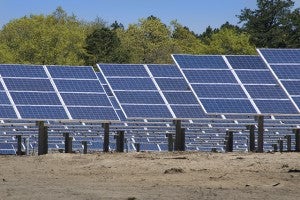 What do rural electric cooperatives have in common with United States military bases? They all want clean, reliable, affordable energy.
What do rural electric cooperatives have in common with United States military bases? They all want clean, reliable, affordable energy.
Rural electric cooperatives are not-for-profit electric utilities that provide reliable, at-cost electricity to their members. They’re ingrained in the American landscape: more than 900 rural cooperatives serve more than 42 million customers in 47 states, accounting for 12 percent of all U.S. electricity sales. Because of their market share and core mission to provide affordable, “at-cost” electricity, co-ops represent a huge (and largely untapped) clean energy opportunity. One way they’re starting to tap this potential is through partnerships with local military bases.
The U.S. Department of Defense (DoD), which operates more than 300 domestic bases, is federally mandated to lower its energy consumption – and for good reason. The DoD is our nation’s largest single energy user, and as a result, has committed to expanding its clean energy portfolio to cut energy use. Each military service has ambitious goals to deploy one gigawatt of on-site renewables in the near future, and many are jump-starting these efforts on bases across the United States.
Rural cooperatives and military bases are often neighbors, creating the potential for productive collaboration. Their ability to share expertise and experience between each other is leading to new cost-cutting techniques and technological developments. And while this type of partnership is still rare, we wanted to highlight two examples from Kentucky and New Jersey with the hope that more electric cooperative-military partnerships might spring up across the nation.
[Tweet “Electric co-op + #military partnerships are an untapped source of big clean energy potential”]
Collaboration in Kentucky
In Kentucky, the Pennyrile Rural Electric Cooperative and the Army’s Fort Campbell are working together on a five megawatt solar array, enough to power 463 homes. The project, funded in part by grants from the state of Kentucky and the Department of Energy, represents a model for energy solutions that meets the needs of all stakeholders.
The solar installation will be the largest in Kentucky and save 4.7 million tons of carbon dioxide emissions annually.
Rick McCoy, Fort Campbell’s energy manager, gets right to the point: “We’re making clean energy.…What more could you say? It’s a great opportunity to do the right thing.”
“We are going to use the power to support the mission of the Soldiers,” McCoy said.
New Jersey base connects with its rural cooperative
In New Jersey, Sussex Rural Electric Cooperative is helping the Army deploy 580 kilowatts of solar photovoltaics at its Picatinny Arsenal. It is expected to save $56,500 a year initially, and up to $97,500 when the project expands.
“The cool thing about this project is that the site was the base’s old burning grounds, and we couldn’t use it for buildings or to construct anything like that,” said Gricel Rivera, energy engineer. “So we were looking for a way to utilize that land and had been looking for a while to bring in solar, and it clicked.”
Progress through partnerships
Diverse, multi-stakeholder partnerships are a key part of many industries, and they are critical to scaling up clean energy. Partnerships like the ones in Kentucky and New Jersey not only bolster national security and cut energy costs, they also boost energy resiliency in our communities. They spark innovation and spur economic growth, important benefits for the military and rural cooperatives. These partnerships show great promise.
Photo source: Flickr/Brookhaven National Laboratory









